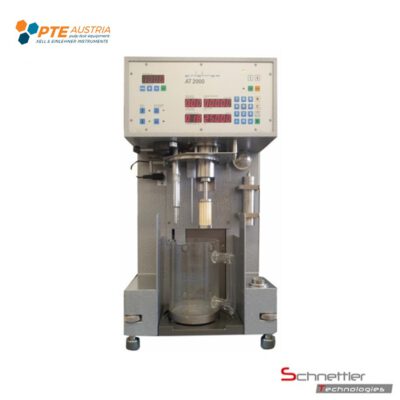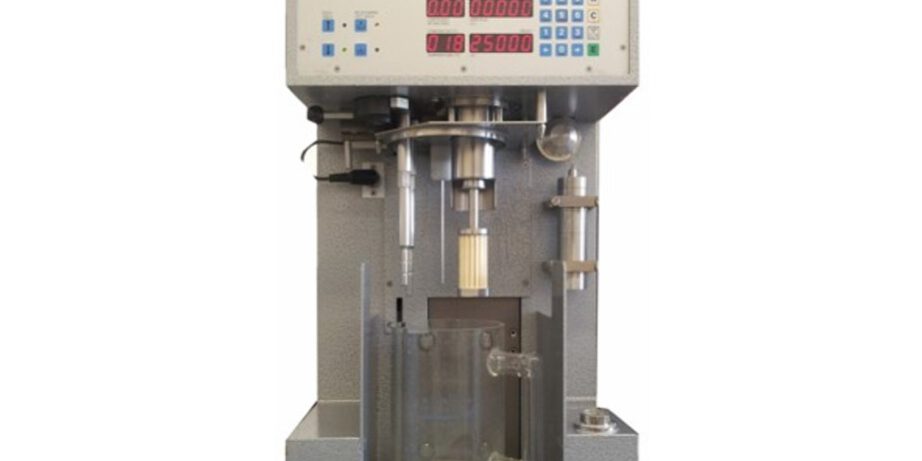
Abrasion Tester AT 2000
Manufacturer: PTE-Pulp Test Equipment GmbH
(formerly manufactured and sold by Xell GmbH)
The AT 2000 abrasion tester is specially designed to determine the wear effect of fillers and pigments of various origins and structures (platelet-shaped and rhombohedral, e.g. clay and CaCO) on paper machine plastic screens. Sieve designs and suction pad materials can also be checked.
Description:
The wear effect of a filler or pigment is defined by the loss of material in a test sieve. The test sieve suffers from the loss of material (thread abrasion) due to the sliding friction stress of a rotating body as Al oxide ceramic strips in an aqueous suspension of the filler or pigment to be tested. The loss of material in the test sieve, which occurs after a certain running distance at a defined contact pressure, serves as a comparison value for the wear effect of the filler or pigment tested.
A plastic screen wraps around a ceramic strip rotating body, similar to a band brake. The rotating body, which is mounted on the vertical drive shaft, is open at the top. The test sieve, which is attached to a fixed holding rod and a holding rod which can be pivoted about this fixed holding rod, is pressed against the rotating body by a load weight. The test sieve and rotating body are completely immersed in the suspension of the filler or pigment contained in a glass test cylinder. The suspension gets partly from the inside through the slots of the rotating body between the ceramic strips and the adjacent test sieve, partly through the suction created between the sieve and the rotating body. The suspension is constantly mixed thoroughly by rotating the ceramic strip body.
Theoretically, the abrasion area is 12.5 cm2 (rotating body circumference = 100 mm, sieve width 25 mm, wrap angle = 180 °).
The fabric tension is max. 2000 g by combining partial weights.
The wire path can be varied up to max. 99,999 m can be selected. The route already completed is displayed continuously. If the screen tears off before the end of the preselected running distance, the device switches off and the running distance reached can be read off.
The running speed of the rotating body is approx. 333 m / min. The duration of the experiment is then z. B. at area code 25,000 m about 75 min. The current friction factor is constantly displayed using a built-in load cell.
A temperature sensor immersed in the suspension makes it possible to read the respective suspension temperature. The maximum permissible temperature can be preselected (maximum value 80 ° C); when this limit is reached, the device switches off.
All operating states can be continuously recorded via an analog and an RS232 interface.
The ceramic slat rotating body consists of 16 circularly arranged round bars made of Al-oxide ceramic or similar suction pad material with a flat ground surface that touches the screen. Due to the flat grinding of the round bars, 16 geometrically identical overrun edges are created at the same time. This arrangement of strips and slots corresponds approximately to the open and closed area of a flat suction device in a paper machine. After a certain running-in phase, no measurable wear or change over time can be determined on the screen-contacting surfaces of the rotating body.
The scope of delivery also includes a test sieve station as an auxiliary device with the following functions:
• Correct clamping of the test sieve in the clamping pieces also supplied.
• Punching out two adjacent sieve samples, one sample from the rubbed-off sieve surface and, for comparison, the second sample from the sieve surface that is not touched by the ceramic strip rotating body, that is to say not rubbed off. These two sieve samples are used to determine the loss of material (thread wear).
• Depot for test sieves, ceramic bar swivel bodies, equipment utensils

